
The Seoul Metropolitan Subway is a metropolitan railway system consisting of 23 rapid transit,light metro,commuter rail and people mover lines located in northwest South Korea. The system serves most of the Seoul Metropolitan Area including the Incheon metropolis and satellite cities in Gyeonggi province. Some regional lines in the network stretch out beyond the Seoul Metropolitan Area to rural areas in northern Chungnam province and western Gangwon Province,that lie over 100 km (62 mi) away from the capital.

The Tokyo Metro is a major rapid transit system in Tokyo,Japan,operated by the Tokyo Metro Co. With an average daily ridership of 6.84 million passengers,the Tokyo Metro is the larger of the two subway operators in the city;the other being the Toei Subway,with 2.85 million average daily rides.
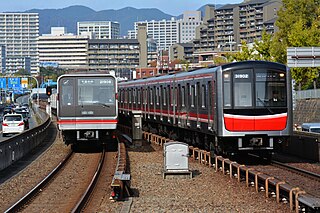
The Osaka Metro is a major rapid transit system in the Osaka Metropolitan Area of Japan,operated by the Osaka Metro Company,Ltd. It serves the city of Osaka and the adjacent municipalities of Higashiosaka,Kadoma,Moriguchi,Sakai,Suita,and Yao. Osaka Metro forms an integral part of the extensive mass transit system of Greater Osaka,having 123 out of the 1,108 rail stations (2007) in the Osaka-Kobe-Kyoto region. In 2010,the greater Osaka region had 13 million rail passengers daily of which the Osaka Municipal Subway accounted for 2.29 million.

The Toronto subway is a rapid transit system serving Toronto and the neighbouring city of Vaughan in Ontario,Canada,operated by the Toronto Transit Commission (TTC). As of September 2023,the subway system is a rail network consisting of three heavy-capacity rail lines operating predominantly underground. As of December 2022,three new lines are under construction:two light rail lines and one light metro line.
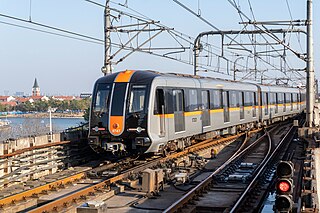
The Shanghai Metro (Chinese:上海地铁;pinyin:Shànghǎi Dìtiě;Shanghainese:Zaon6he5 Di6thiq7) is a rapid transit system in Shanghai,operating urban and suburban transit services to 14 of its 16 municipal districts and to the neighboring township of Huaqiao,in Kunshan,Jiangsu Province.
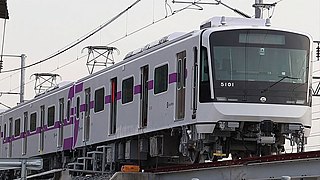
Seoul Subway Line 5 of the Seoul Metropolitan Subway,dubbed the purple line,is a long line crossing from west to the east across the Seoul National Capital Area,South Korea. It is one of two subway lines in Seoul to cross under the Han River,which is done at two points. The main line runs through to Hanam Geomdansan Station while the branch line from Gangdong Station terminates at Macheon Station. In 2019,Line 5 carried an annual ridership of 334 million or about 915,000 passengers per day.
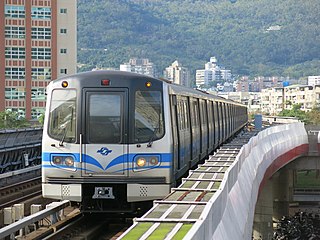
Taipei Mass Rapid Transit (MRT),branded as Metro Taipei,is a rapid transit system serving the capital Taipei and New Taipei City in Taiwan.

Seoul Subway Line 2,also known as the Circle Line,is a circular line of the Seoul Metropolitan Subway. The line running clockwise is called the "inner circle line" and the counter-clockwise line is called the "outer circle line". This is Seoul's most heavily used line,and consists of the main loop,the Seongsu Branch and the Sinjeong Branch for a total line length of 60.2 km (37.4 mi). The Line 2 loop is the third longest subway loop in the world after Moscow Metro Bolshaya Koltsevaya line and Beijing Subway Line 10. In 2019,Line 2 had an annual ridership of 812 million passengers or 2.2 million passengers per day.

Seoul Subway Line 6 is a line of the Seoul Metropolitan Subway. The route connects Eunpyeong-gu and Jungnang-gu in a U-shaped manner,running through Yongsan-gu and Seongbuk-gu. It does not cross the Han River. It is mainly used to connect to the northern outskirts of Seoul and to relieve the traffic on other lines.

Seoul Metro Corporation (Korean: 서울메트로) was a municipal-owned corporation owned by the Seoul Metropolitan Government. Established in 1970,it was,with Seoul Metropolitan Rapid Transit Corporation and Korail,one of the major operators of Seoul Metropolitan Subway. The company merged with Seoul Metropolitan Rapid Transit Corporation in 2017.

Platform screen doors (PSDs),also known as platform edge doors (PEDs),are used at some train,rapid transit and people mover stations to separate the platform from train tracks,as well as on some bus rapid transit,tram and light rail systems. Primarily used for passenger safety,they are a relatively new addition to many metro systems around the world,some having been retrofitted to established systems. They are widely used in newer Asian and European metro systems,and Latin American bus rapid transit systems.

Seoul Subway Line 9,operated by Seoul Line9 Operation,is a subway line in Seoul,part of the Seoul Metropolitan Subway. The line runs east from Gaehwa station or Gimpo International Airport station along the south bank of the Han River towards VHS Medical Center in Gangdong. In 2019,Line 9 had an annual ridership of 225 million or about 616,000 people per day.
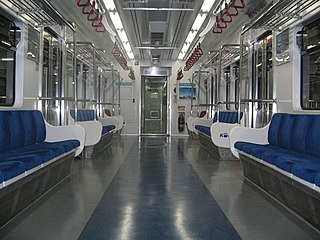
There are many types of trains in Seoul but they are generally similar to each other. All Seoul Metropolitan Subway rolling stock follow the Japanese-style commuter/subway train interior layout of all-longitudinal seating with luggage racks above seats. Typically,train cars have four pairs of doors on each side. In between the doors are rows of either cushioned or non-cushioned seats for 7 people,except for the outer ends of each wagon where there are smaller rows of seats for 3 people,marked for the use by the elderly,disabled passengers,and pregnant women.
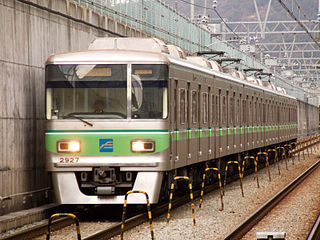
The Busan Metro is the urban rail system operated by the Busan Transportation Corporation of Busan,South Korea. The metro network first opened in 1985 with seventeen stations,making Busan the second city in South Korea and third in the Korean Peninsula to have a metro system. The Metro itself consists of 4 numbered lines,covering 116.5 kilometres (72.4 mi) of route and serving 114 stations. Including the BGL and the Donghae Line,the network covers 205.6 kilometres (127.8 mi) of route and serving 158 stations.

Geumjeong Station is a ground-level metro station on lines 1 and 4 of the Seoul Subway network in South Korea. The station is in Gunpo,a city approximately 15 km (9.3 mi) south of Seoul in Gyeonggi Province,between the cities of Anyang and Suwon. The name means that the land is covered with waves everywhere and that the water wets women's clothes.

The history of rapid transit began in London with the opening of the Metropolitan Railway,which is now part of the London Underground,in 1863. By World War I,electric underground railways were being used in Athens,Berlin,Boston,Buenos Aires,Budapest,Glasgow,Hamburg,Istanbul,Liverpool,New York City,Paris,and Philadelphia.

Oido station is a subway station on Seoul Subway Line 4 and the Suin–Bundang Line in Siheung,South Korea. It is the current southwestern terminus of Seoul Subway Line 4 located almost 30 kilometers southwest of Seoul,connecting Oido to other parts of Korea. A commuter rail trip between this station and Seoul Station takes over an hour,and a train servicing depot is located nearby. The name of the station was decided by the surrounding area Oido island.

Rapid transit or mass rapid transit (MRT),also known as heavy rail or metro,is a type of high-capacity public transport that is generally built in urban areas. A rapid transit system that primarily or traditionally runs below the surface may be called a subway,tube,or underground. Unlike buses or trams,rapid transit systems are railways,usually electric,that operate on an exclusive right-of-way,which cannot be accessed by pedestrians or other vehicles. They are often grade-separated in tunnels or on elevated railways.

Incheon Transit Corporation (인천교통공사),formerly known as Incheon Rapid Transit Corporation (인천지하철공사) currently operates the Incheon Subway,Wolmi Sea Train,Incheon Bus information,Incheon Bus Terminal,Call taxi for the handicapped in Incheon,South Korea,established in 1993. In 2011 Incheon Transit Corporation merged with ′Incheon Metro′,established in 1998 to operate Incheon Subway Line 1,Incheon Subway Line 2,the section of Seoul Subway Line 7 between Kkachiul &Seongnam,&the Incheon Airport Maglev. In the future it also has plans to operate Line 3.

Seoul Transportation Corporation,branded as Seoul Metro,is a municipal-owned corporation owned by Seoul Metropolitan Government,and one of the two major operators of Seoul Metropolitan Subway with Korail.




















